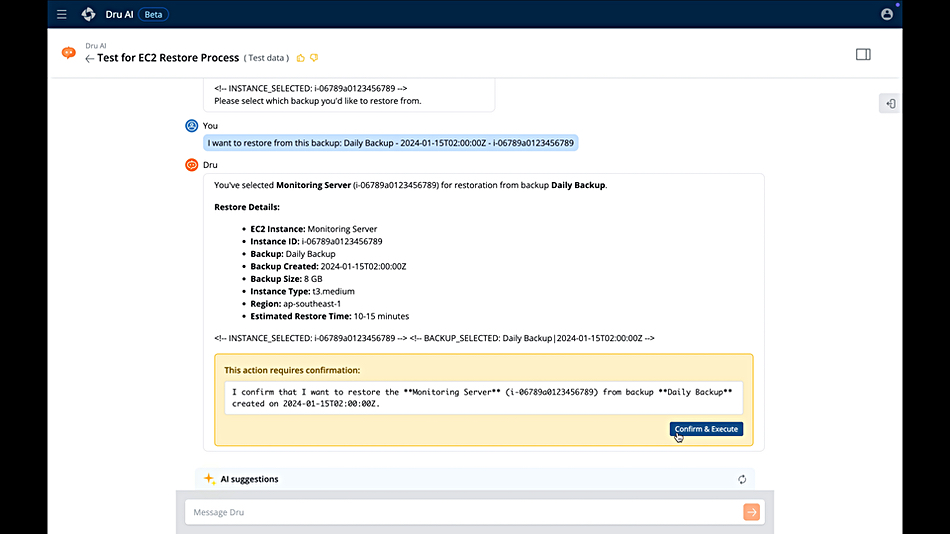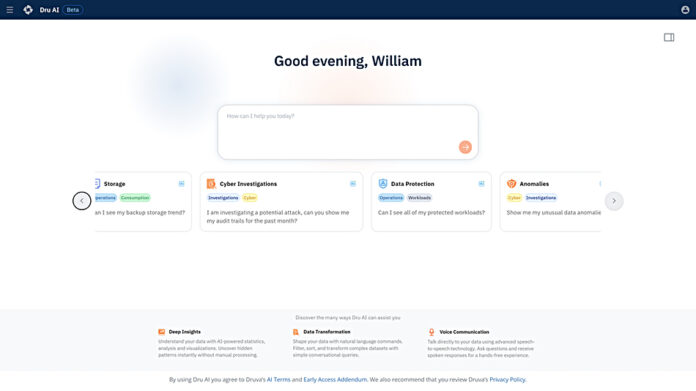Data protection supplier Druva is adding a group of agents to its DruAI suite to bolster cyber resilience with greater speed, simplicity, and confidence.
The autonomous agents, built with Amazon Bedrock AgentCore on AWS, represent an agentic system to interpret natural language requests, analyze data, and take meaningful action to secure, recover, and manage the user’s data.

Jaspreet Singh, CEO and co-founder of Druva, stated: “Our vision is that AI will not only assist users, but also execute complex tasks, respond to threats in real time, and deliver a dynamic user interface personalized to users’ needs. Today’s announcement takes a leap forward in that direction. Agentic AI will completely transform how users interact with their software, and we’re embedding that functionality directly into our platform at no added cost to the customer.”
There are three types of DruAI agents:
- Data Agents surface key signals and trends from telemetry, risk indicators, and history.
- Help Agents guide users by troubleshooting problems, investigating incidents, and recommending next steps.
- Action Agents carry out specific tasks, such as recovering workloads, creating protection policies, or adjusting retention to optimize cost.
By working together, they can enable customers to restore entire applications with one command, orchestrate full workload recovery, and eliminate the need to manually piece together infrastructure components. For example, DruAI Agents can restore an EC2 instance, including its configuration, volumes, and associated networking in a single step using a simple prompt.
Cyber investigations can be improved by removing the need to inspect dashboards, logs, and alerts to understand what’s changed and what’s at risk. Data and Help Agents can automatically surface anomalies, flag suspicious patterns, and generate exec-level summaries to support faster decisions and responses.

DruAI includes an agent-testing option via the use of built-in synthetic datasets, allowing customers to test AI prompts, simulate recovery scenarios, and evaluate outputs within a secure sandbox. Druva says this helps teams validate results, explore new use cases, and train users before applying AI in production environments.
The company says that, over the past year, more than 3,000 customers and 10,000 users have used DruAI to help investigate and fix issues, with more than 11,000 AI-powered conversations across recovery, configuration, and support workflows. It says 63 percent of customer issues are resolved directly with DruAI. Support cases requiring human intervention are resolved 58 percent faster with DruAI using telemetry-based context. Also, by being built with strict data integrity controls, Druva claims DruAI has maintained a zero percent hallucination rate.
DruAI does not allow users to access any data they are not authorized to access. It and its agents do not access or learn from customer data, which is encrypted on the Druva platform and is not shared with any third parties. DruAI is designed with isolated large language models (LLMs) and private retrieval-augmented generation (RAG). This, Druva says, ensures secure analysis and works exclusively with an organization’s metadata to safeguard its sensitive information.
Over the next 12 months, Druva’s DruAI plans include reducing the average time-to-resolution for cyber investigations by up to 70 percent, enabling up to 90 percent of routine data protection tasks through natural language interactions, and shortening backup troubleshooting time from hours to minutes.
Druva’s DruAI agents are available now. Read more about Druva’s vision and strategy for agentic data security in a blog from CEO Singh.
Comment
Druva and Cohesity, with Gaia, are among the most advanced cyber-resilience suppliers from an AI agent point of view. We think Druva’s competitors are likely working on similar agent functionality. A possible future move by Druva would be to integrate DruAI with a customer’s AI pipelines and open up its stored backup data set for AI model and agent analysis and processing.








